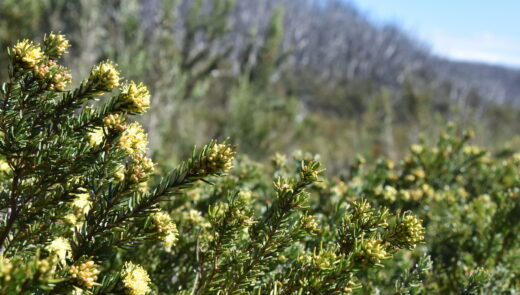Mueller’s Bush Pea, also known as Pultenaea muelleri, is a shrub that grows to be about 3 metres in height, similar in appearance to the Balm Mint Bush with its yellow petals and bright red centre.
Heading into early October you can expect to see a progression of Hovea, Bush-peas, Mints, Trigger plants and Billy Buttons – a truly unique looking plant with narrow woolly leaves and globe shaped flowers on the end of their long stems, almost like a little golden pom pom!
One of the best places to see this beautiful display of plant species is along the Echo Flat Walk, an easy walk along the ski trails, starting from Lake Mountain Village and winding its way through Snow Gum woodland. From here you will have the opportunity to see firsthand how the snow gums have been recovering since the fires and a stunning display of wildflowers that have now become to take over.
Lake Mountain has a variety of bush walks for you to choose from. Each route will show you through the beautiful mountainous scenery, as well expose you to different species of vegetation. From the stunning wildflowers to breathtaking views of the Snow Gum woodland and Mountain Ash, you really won’t be able to look away!
If you’re new to bushwalking and keen to get started, we’ve put together an article with some bushwalking tips for beginners to help you out. With the Christmas holidays right around the corner, it’s the perfect time to get away, go sight-seeing and set out on a new adventure. With that in mind you should consider heading down to Lake Mountain, located just 2 hours from Melbourne CBD.
There really is no excuse for missing out – your adventure awaits. See you soon!
Stay COVIDSafe this summer by staying up to date on the latest physical distancing and restrictions via the https://www.coronavirus.vic.gov.au/ website.





